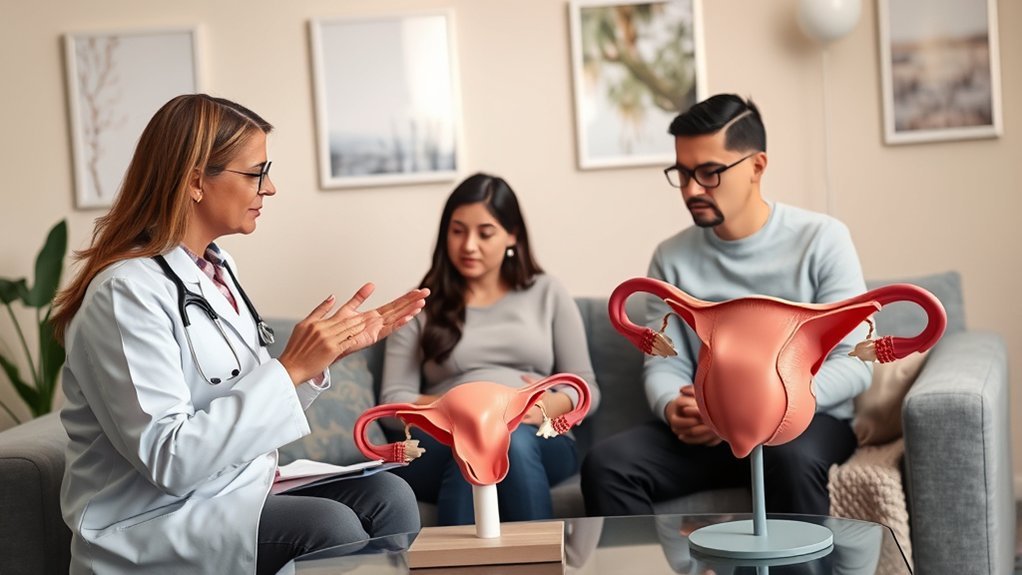Spotting in the first trimester can feel like a flickering candle in a dark room—uncertain and unsettling. It’s crucial to navigate this delicate phase with care and knowledge. Understanding what’s normal and what’s not can greatly impact your peace of mind. As you explore the do’s and don’ts of handling spotting, you’ll uncover essential strategies to guarantee both your physical and emotional well-being during this pivotal time.
Understanding Spotting: What Is Normal?

When you’re in the first trimester of pregnancy, it’s natural to wonder about any spotting you might experience. Spotting can vary in color, from light pink to brown, and its intensity can range from very light to more noticeable.
Many women encounter spotting during this stage, and it’s often considered normal, especially if it’s brief and not accompanied by other symptoms. This can be your body’s way of adjusting to pregnancy.
Spotting in early pregnancy is common and often normal, especially if brief and without other symptoms.
However, it’s vital to pay attention to how you feel overall. If spotting becomes heavy or is accompanied by pain or cramping, reaching out to your healthcare provider is essential.
Understanding what’s typical can help ease your worries and allow you to focus more on your pregnancy journey.
Common Causes of Spotting in the First Trimester

While spotting in the first trimester can be alarming, it’s often caused by a variety of common factors that many women experience. One of the most frequent reasons is implantation bleeding, which occurs when the fertilized egg attaches to the uterine lining.
Hormonal changes can also contribute, as your body adjusts to pregnancy. In some cases, cervical changes or irritation, such as from a Pap smear or sexual intercourse, may lead to light spotting.
Additionally, some women experience spotting due to conditions like subchorionic hemorrhage, where blood collects between the placenta and uterine wall.
When to Seek Medical Attention

How can you tell if your spotting is a cause for concern? It’s important to listen to your body and recognize when to reach out for medical help.
If you experience any of the following, don’t hesitate to contact your healthcare provider:
- Heavy bleeding: If you’re soaking through a pad in an hour or less.
- Severe cramping: Intense pain that doesn’t ease with rest or over-the-counter pain relief.
- Passage of tissue: If you notice tissue or clots in your discharge.
- Symptoms of infection: Such as fever, chills, or foul-smelling discharge.
Trust your instincts—your health and peace of mind are paramount.
It’s always better to err on the side of caution.
Do’s: How to Monitor Your Spotting
Monitoring your spotting during the first trimester is essential for understanding your body’s signals. Keep a detailed log of when spotting occurs, its color, and any associated symptoms like cramping.
Note the duration and frequency as well. This information can help you and your healthcare provider identify patterns and determine if further investigation is needed.
Pay attention to changes in your spotting; for instance, if it becomes heavier or is accompanied by severe pain, seek medical advice promptly.
Also, consider tracking your overall emotional and physical health, as stress can impact your experience.
Don’ts: Mistakes to Avoid During Spotting
When you experience spotting in the first trimester, it’s essential to avoid certain mistakes that could jeopardize your health.
Ignoring symptoms, self-medicating without professional guidance, and overexerting yourself can complicate your situation.
Staying informed and cautious will help you navigate this sensitive time more safely.
Ignoring Symptoms Completely
Although spotting during the first trimester can be common, ignoring your symptoms completely is a mistake you don’t want to make.
It’s vital to pay attention to your body and recognize when something feels off. Here are some signs you shouldn’t overlook:
- Heavy bleeding – If you notice a significant increase in blood flow, it’s essential to consult your healthcare provider.
- Severe cramping – Intense pain can indicate complications that require immediate attention.
- Foul-smelling discharge – This could signal an infection, which needs prompt treatment.
- Dizziness or fainting – These symptoms could signify a more serious issue that warrants medical evaluation.
Always prioritize your health and seek guidance when you’re uncertain.
Your well-being and your baby’s are too important to risk.
Self-Medicating Without Guidance
As you navigate the challenges of spotting during the first trimester, it’s essential to avoid self-medicating without professional guidance.
While it might be tempting to reach for over-the-counter medications or herbal remedies, doing so can pose risks to both you and your developing baby. Many substances can interact negatively with your pregnancy, potentially worsening your condition or leading to complications.
Instead of guessing what might help, consult your healthcare provider for tailored advice. They can assess your symptoms and recommend safe, effective options.
Overexerting During Spotting
While it’s understandable to want to maintain your normal routine, overexerting yourself during spotting can lead to unnecessary complications.
It’s crucial to listen to your body and prioritize your health. Here are some actions you should avoid:
- Heavy Exercise: Refrain from intense workouts or heavy lifting that can strain your body.
- Excessive Stress: Minimize stressful situations that could affect your emotional well-being.
- Long Hours: Don’t push through long work shifts or commitments that leave you fatigued.
- Skipping Rest: Avoid neglecting rest and relaxation; your body needs time to heal.
Taking it easy during this time can help guarantee a safer and healthier experience for both you and your baby.
The Role of Hormones in Early Pregnancy Spotting
Hormonal fluctuations play an essential role in early pregnancy, and understanding them can help you make sense of any spotting you may experience.
As your body adjusts to new hormone levels, the uterine lining may become more sensitive, leading to light bleeding.
Recognizing how these changes affect your pregnancy can ease your concerns and guide you through this delicate time.
Hormonal Fluctuations Explained
Understanding the hormonal fluctuations that occur during early pregnancy is essential, especially when it comes to spotting. These hormonal changes can affect your body in various ways, and recognizing them can help you navigate this sensitive period.
- Human Chorionic Gonadotropin (hCG): This hormone rises rapidly in early pregnancy, supporting fetal development.
- Progesterone: It helps maintain the uterine lining but can cause slight spotting as levels fluctuate.
- Estrogen: Increased estrogen levels can lead to changes in cervical tissue, sometimes resulting in light bleeding.
- Relaxin: This hormone relaxes the uterus but may also affect blood vessels, contributing to spotting.
Impact on Uterine Lining
As your body undergoes significant changes during early pregnancy, the role of hormones in affecting the uterine lining becomes essential.
Hormones like progesterone and estrogen are important in thickening the uterine lining to support the developing embryo. When these hormone levels fluctuate, it’s common to experience spotting. This can occur as the embryo implants itself into the lining, causing slight bleeding.
While this is often normal, it’s crucial to monitor your symptoms. If you notice heavy bleeding or severe pain, don’t hesitate to reach out to your healthcare provider.
Understanding these hormonal influences can help you navigate this exciting yet challenging time, ensuring you prioritize both your health and your baby’s development.
Lifestyle Tips for a Healthy First Trimester
While steering through the early weeks of pregnancy can be both exciting and overwhelming, adopting a few key lifestyle tips can help guarantee a healthy first trimester.
Here are some essential practices to contemplate:
- Stay Hydrated: Drink plenty of water to support your body’s increased needs.
- Eat Nutritious Foods: Focus on a balanced diet rich in fruits, vegetables, whole grains, and lean proteins for essential nutrients.
- Get Plenty of Rest: Prioritize sleep and allow your body to recover from fatigue.
- Engage in Gentle Exercise: Incorporate light activities like walking or prenatal yoga to boost your mood and energy levels.
Emotional Support and Coping Strategies
Maneuvering the emotional landscape of your first trimester can be challenging, so it’s essential to seek support and develop effective coping strategies. Surround yourself with understanding friends and family who can listen and empathize with your feelings.
Consider joining a support group, either in person or online, where you can share experiences and gain insights from others facing similar challenges.
Practice self-care by engaging in activities that relax you, such as gentle yoga, meditation, or journaling. Don’t hesitate to express your feelings; it’s okay to feel anxious or scared.
Additionally, consult your healthcare provider if overwhelming emotions persist. Remember, it’s normal to experience a rollercoaster of emotions during this time, and seeking help is a sign of strength, not weakness.
Frequently Asked Questions
Can Stress Contribute to Spotting During the First Trimester?
Yes, stress can contribute to spotting during the first trimester. Your body’s hormonal changes and emotional strain may impact your pregnancy. It’s crucial to manage stress and consult your healthcare provider for personalized guidance.
Is It Safe to Exercise if I’m Spotting?
If you’re spotting, it’s best to consult your healthcare provider before exercising. They can assess your situation and provide tailored advice, ensuring you prioritize both your health and your baby’s well-being during this time.
What Types of Medications Should I Avoid While Spotting?
You should avoid nonsteroidal anti-inflammatory drugs (NSAIDs), certain supplements, and any medications not approved by your healthcare provider while spotting. Always consult your doctor to confirm the medications you take are safe for your situation.
Can Spotting Indicate a Miscarriage Every Time?
Spotting doesn’t always mean a miscarriage; it can be as misleading as a mirage. Many women experience spotting without losing the pregnancy. However, it’s essential to consult your healthcare provider for personalized advice and reassurance.
How Can I Differentiate Between Spotting and a Heavier Flow?
You can differentiate spotting from heavier flow by observing color and consistency. Spotting is often light and brownish or pink, while a heavier flow is usually bright red and more substantial, possibly requiring a pad or tampon.
Conclusion
In the journey of early pregnancy, understanding spotting is like steering through a winding road; staying informed can guide you safely. By monitoring your symptoms and seeking help when needed, you’ll prioritize both your health and your baby’s. Remember, it’s okay to feel a mix of emotions during this time—lean on your support system and embrace self-care. With knowledge and awareness, you can maneuver through this delicate phase with confidence, ensuring a smoother ride ahead.
